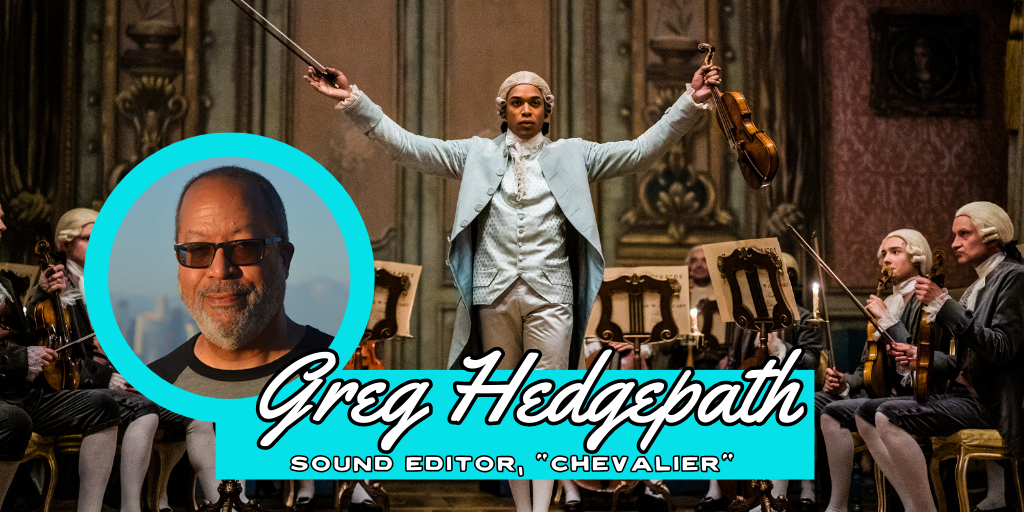(Image: Searchlight Pictures/20th Century Fox, IMDb)
Chevalier, the biopic about Joseph Bologne, Chevalier de Saint-Georges, is teaching audiences about the little-known concert violinist, fencer, and member of the landed gentry in 18th century France. Played by Kelvin Harrison Jr., Joseph brought a new style to the French aristocracy, and his story was nearly lost to time. Thankfully, his legacy is now firmly cemented in Black history and world history alike.
Greg Hedgepath had a front row seat to the creation of the film as the film’s sound editor. In a recent Zoom interview I had with him, Hedgepath said he didn’t know there were still recordings of Bologne’s work (one of which you can hear below).
“I think we’re going to be hearing a lot more of him once the movie’s released,” he said.
He also talked about some of the history behind Bologne’s work.
“I mean, if you read the Wikipedia history, you may have read some of this, but he was a contemporary of Mozart. He lived at the same time. And they even lived in the same house at one time. And historians have shown that there are pieces of, uh, Chevalier or Joseph Bologne’s work that [have ended] up in Mozart’s work. In other words, he borrowed, let’s say–Mozart borrowed from Joseph Bologne. We can prove that.”
I remarked how incredible it has been to hear music from a Black person from this time period. Such a thing is unfortunately rare because Black works were often not documented, destroyed, or as Mozart proves, stolen. Hedgepath said that for Bologne’s work to survive despite the odds against him proves just how extraordinary he was.
“I think as has always been the case since probably before slavery, but certainly in this country since slavery, where you have this Black man, a former slave, you know, not as educated as some of his peers, to rise up above them,” he said. “So once he got to France and was in this music academy, he became a master fencer…They don’t show it in the film [but] there’s a competition [and] he ended up beating his instructor, [who was] then one of the biggest fence masters in France…He also was in the service of the Queen. So he is in the military and his troops performed some amazing feats.”
“[H]e was just a Renaissance man. Pretty incredible dude. But you have to be, to have survived [through] history, to have survived this long because it turns out that Napoleon was very pro-slavery and very anti-Black,” he continued. “So he did everything to specifically erase Joseph Bologne from history. And he almost did it. Some, some of his works don’t exist because of Napoleon.”
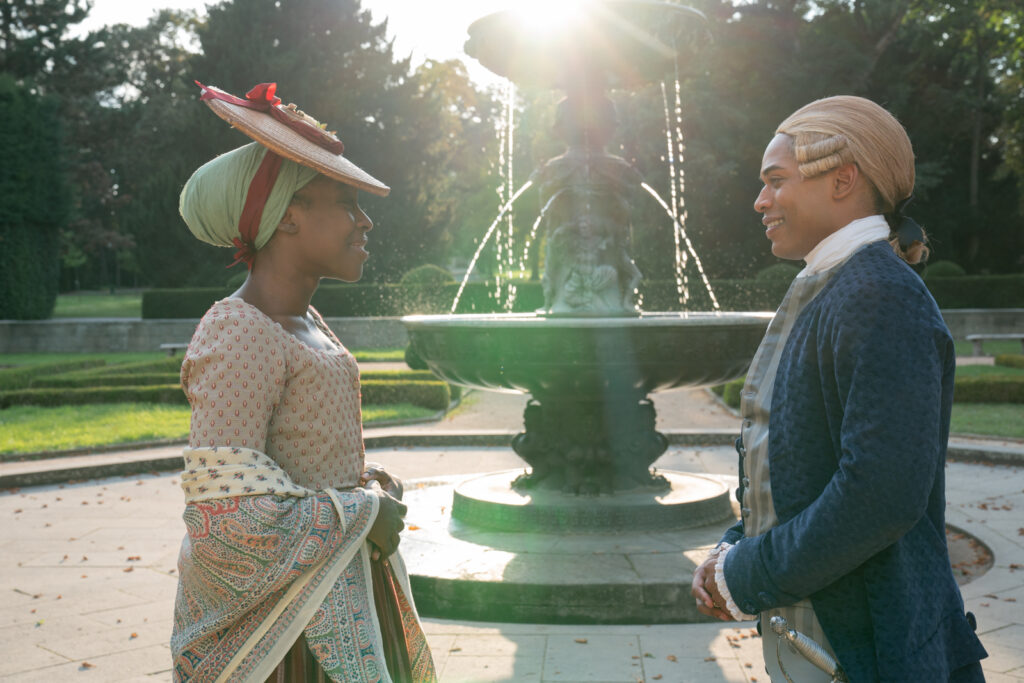
Hedgepath is also quite extraordinary in his own right as one of the few Black sound editors in the industry.
“I have a partner that I work with, her name is Bobbi Banks, and we kind of co-supervise a lot, but other than her, there aren’t very many other black people doing this job because the bar to get into this business is pretty high,” he said. “And, you know, most of the time when you talk to African-Americans in this business, they’re very smart or they’ve had certain opportunities not handed to them, but doors have opened and they’ve seen it and gone through it, which has been, you know, the case in my life anyway. But you have to be ready at all times. You can’t just kind of waltz your way through this business. You have to study and read and talk to people and be ready when the opportunity comes. And I think the case was the same for Joseph Bologne. He was just ready because he was such an amazing composer and musician.”
Hedgepath said that sound editing involves “taking just a lot of different elements” and combining them together on a timeline.
“Let’s say you’re doing a comedy, somebody’s always getting slapped in the face by one guy,” he said. “We may have six different sound effects that we layer up for that slap, and then we can take them and move them around and use them elsewhere. So that’s a basic idea of what sound editing is…Let’s say a car is skidding around a corner. Well, normally, you would think you just hold out a mic, you have a car skid around a corner and you record that and that’s it. But it doesn’t work like that at all actually. You have to have all the individual elements, like you need to have the tire skids, the tire, the brake squeak, if someone’s backing up, if you hit something, you got to have that. But we also add more to the sound. So if somebody’s skidding around the corner, you may hear a tire squeal. You may have pig squealing, horse whinnying, glass crunches. And we sometimes process them so they all kind of blend together. But the process of sound editing means you have to have a good sense of what you want to do. You can’t just throw up a bunch of stuff against the wall and see what sticks.
The sounds, foley work (i.e. footsteps) and the dialogue are all edited, cleaned, all become what’s known as a “pre-mix,” which is then funneled down into “pre-dub groups.” The pre-mix as a whole could be thousands of tracks deep, and grouping them helps the sound editor manage all of the different components. For instance, one group would be for the car in the previous example, and that group includes the car itself as well as the tire squeals, brakes, and any other sounds associated with (or caused by) the car. The “print master” includes all of the edited sounds and music, leading up to the final version ready for the screen.
“[T]he key is, If we do our job right, you don’t have a clue what we’ve done,” he said, saying that unless the scene depends on over-the-top sounds, if the audience can notice the sound editing, “it takes them out of the movie.”
“That’s kind of a cardinal sin,” he said. “That’s one thing we can’t do in this business is let people see…the sausage being made as a result.”
With everything that comes with sound editing, it can sound complex and complicated. Hedgepath said that’s exactly right, but after doing it for so long, it comes easy to him.
“It is complex and complicated, and yet, you know, after doing it for years and years, like over 30, maybe 40 years, it’s just second nature,” he said. “It’s probably like a mechanic. If he’s putting an engine together, he’s not necessarily thinking about all the parts. He’s thinking about what he wants that engine to do, and it’s second nature–‘Oh, I need this blower. I need this intake. I need this exhaust, manifold.’ So you just kind of know. It’s to the point where once the picture department turns the picture over to me and I look at it, I just start to hear the sounds in my head. As I hear the sounds, I just write ’em down on my notes that I’m taking.
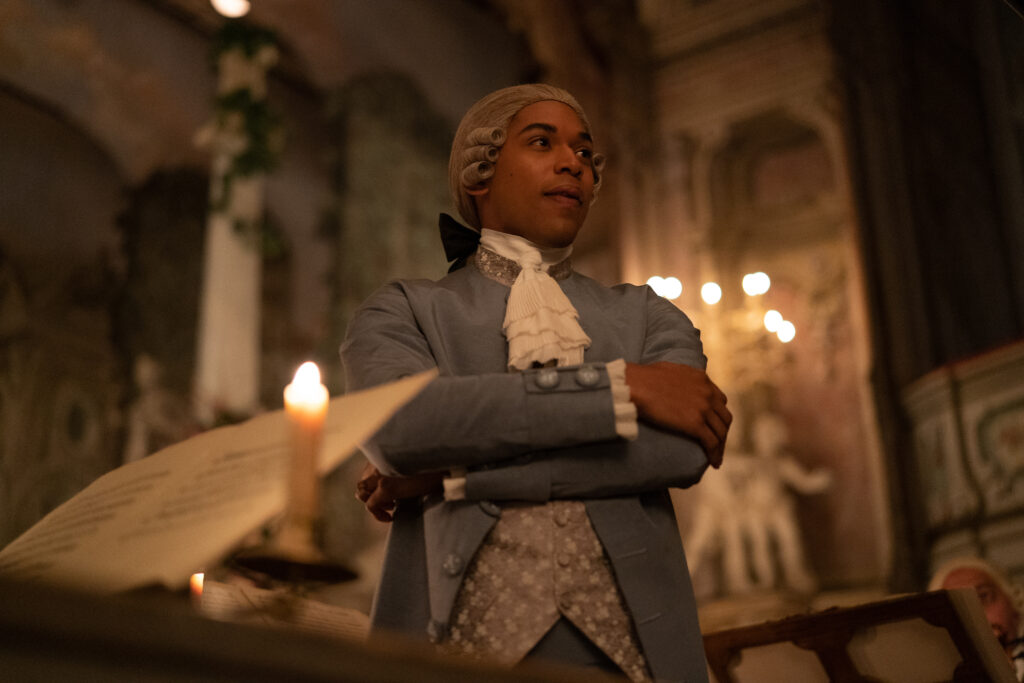
For Chevalier, Hedgepath’s objective was to capture the sounds of a pre-Revolutionary French metropolis which made up Bologne’s world.
“Every film has its own feeling,” he said. “…[W]hen I interviewed with Steven Williams, the director, I told him I couldn’t wait to sink my teeth into this film because I’d worked on all the different elements that go into [making] the sound of this movie, like backgrounds and horses and carriages and cobblestone streets and all that kind of thing, but I hadn’t really done them in a period piece like this.”
“So this piece takes place around the late 1700s, so we had to make sure that everything was very analog, like carriages that squeaked and creaked when they moved,” he continued. “People are walking on cobblestone streets, it’s a different sounding footstep. Same with the horses and the carriages. And also because in this era they didn’t have screens, everybody’s windows are pretty much open. We didn’t put any flies in there, but I’m sure back in the day you had flies everywhere probably, but you can always hear the sound coming from the streets in a room.”
Hedgepath also said that sounds he put in the film include more voices becoming part of the background sound the closer the film gets to the French Revolution.
“We’re hearing more and more voices off screen, kind of wafting into the room to the point where towards the end, they become so loud, you know, people in the streets protesting, rioting, whatever. At that point, they wake up our main character because he has to go to the window to find out what’s going on because there’s so much going on. So that was something we had to think about, just the ambience of the film. Also a big part of the film was the crowds because we’re in a lot of different venues where Chevalier is playing music. And there’s also a fencing scene, so there’s a crowd in that scene, so we had to make sure the crowds really expressed the emotion of not just the scene, but of what was going on at that time.”
“So for example, in one scene towards the beginning, we’re in this grand concert hall and everybody’s dressed up very well, and everybody’s very polite because this is the upper crust of society,” he continued. “Later on in the film, as things change, we’re seeing a performance in front of just the regular people. It’s a free concert, and so just regular people just dress as they normally do and are there and they’re rowdy and just boisterous and having a great old time. So we have to convey that.”
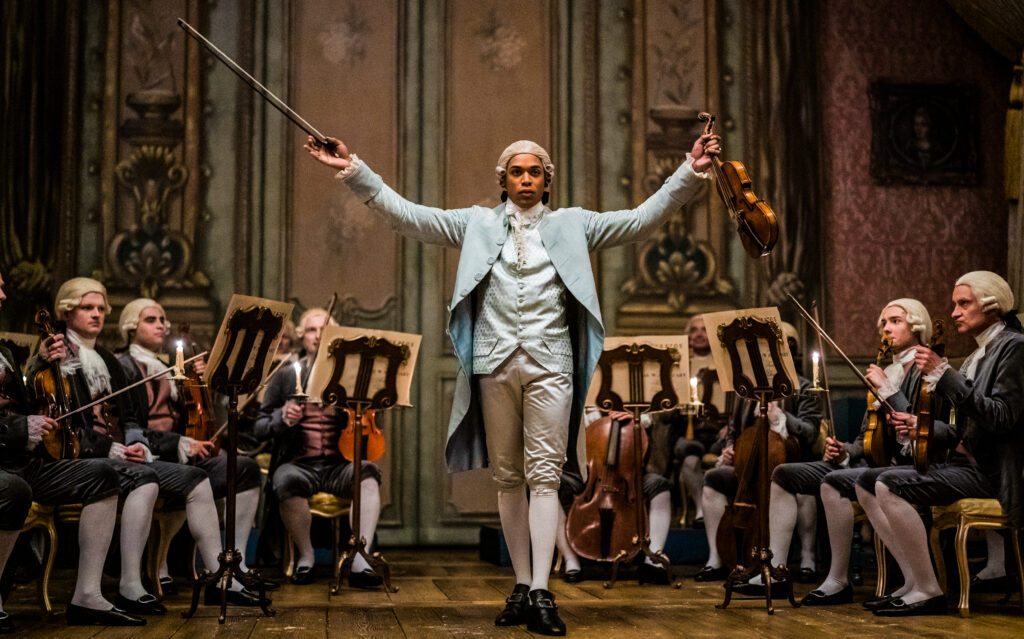
Hedgepath said that crafting the sound for film is “kind of an analog for painting [or] sculpting.”
“I can’t draw, I can’t paint. But fortunately, God gave me this ability,” he said. “I see something and I hear it in my head and immediately [hear] what I want it to be. The hard part is then translating that into this editing system because, you know, I often tell…people who want to get into sound [that] you have to find the right sound for whatever you’re doing…[Y]ou are always thinking about the quality that each sound effect gives off.”
“So regarding Joseph [Bologne], for him, because he’s just a person walking around, he’s not a superhero…what we worked on was everything around him that tells us who he is,” he continued. “So that would be when he’s walking around the street, people are passing him by. You kind of hear them where they’re in the front and then they go to the rear speakers. If you’re in a theater, you really hear them passing by, you hear [what the] distance sounds like. We put in a blacksmith–you never see it, but you hear the ding-ding-ding way off screen, just so you know we’re in a very busy, hustling, bustling area when he’s walking in a certain area.”
Hedgepath also described some other scenes, including a scene that takes place in a pool hall.
“There [are] some things that take place in a pool hall where it’s a common gathering area, not like pool halls now…and sometimes people will get up on the pool tables and give speeches. So…I had to find out from the director who are the people that go there,” he said. “So are they going to be the kind of people who are very quiet and when we hear them they’re just [saying] low key stuff? Or are they very boisterous [and] we hear them laughing and…every once in a while a word will come out? A sound like that would have more peaks in it. That’s what we’re looking for. So we had to figure out each environment he was in, what it sounded like. And even when he is in his home again, as we’re going through the movie and things are getting busier off-screen, what’s that going to sound like? How’s that going to affect him?”
Hedgepath said that even though he learned a lot about Bologne during the editing process, he’s still learning things about him.
“…The thing that that got me is that everything he did, he was superior at it. And in the beginning of the movie–I’m not giving much away. I think it’s in…the trailer–but the last time he sees him, his father [who Hedgepath also acknowledges was also Chevalier’s slave master] says ‘No one can tear down an excellent Frenchman. Always be excellent.’ And so he was excellent in everything he did in his life. And my father [said] something very similar to that and I think it’s reflected in how I approached things. So I would say to anybody, just be excellent.”
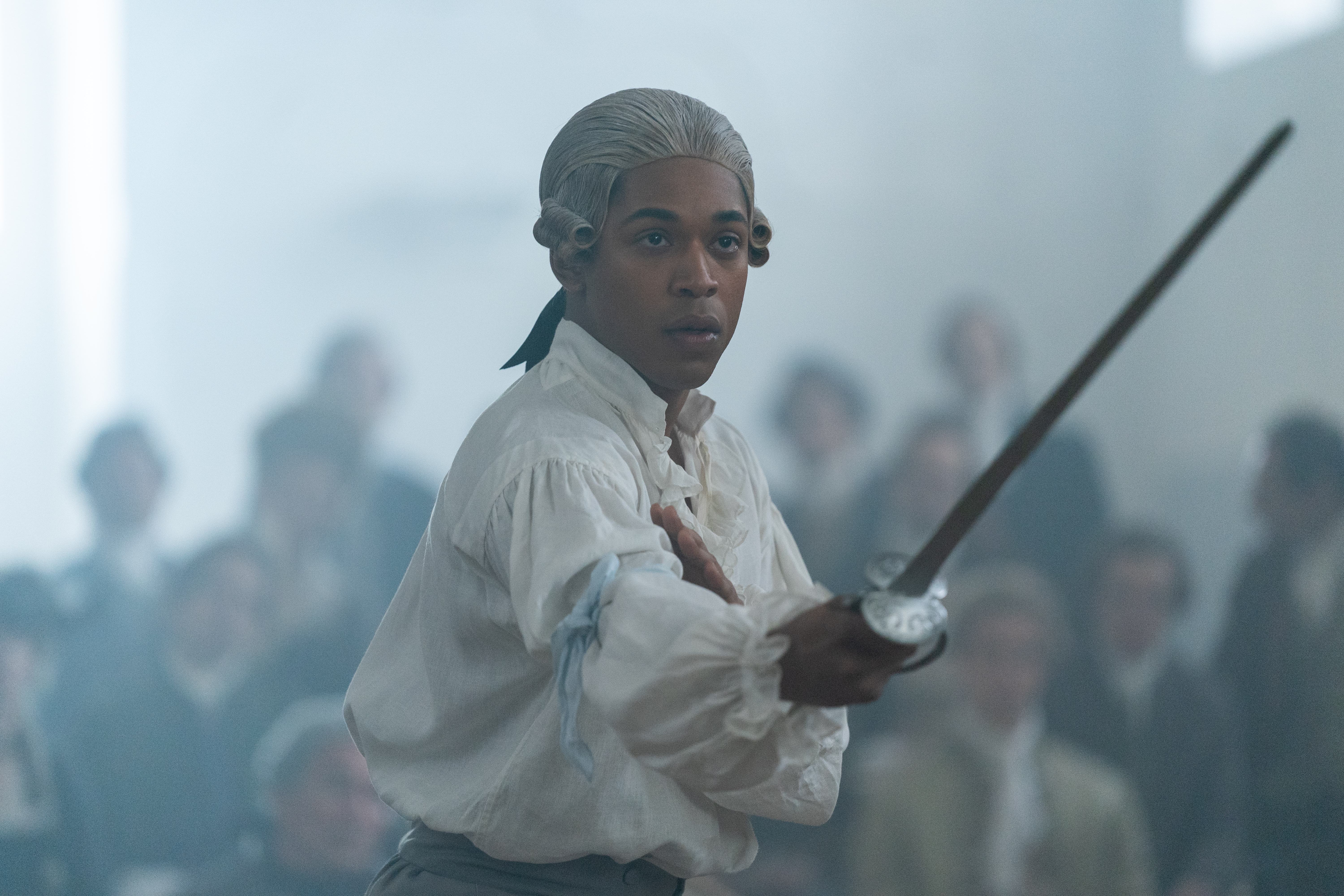
Hedgepath’s excellence can be heard in other fan favorite films and films that are important to the Black experience, including Dolemite Is My Name!, Straight Outta Compton and Selma. Hedgepath said he felt the weight of the moment on him when editing these films.
“I didn’t feel pressure, but yet I understood the weight of the job, to make sure, especially with true stories like Selma or Straight Outta Compton, to really make sure that we don’t overdo it with sound, but [that the sound] really reflects the, the, the nature of what’s going on in the scene,” he said. “I mean, for, for both Selma and Straight Outta Compton, one of the harder things were the crowds because in Selma, you know, there was the Edmund Pettus bridge scene where there’s people running around and the cops are beating them. There are various scenes like that. And then in Straight Outta Compton there are various concert scenes and each one gets bigger and bigger.”
“…I think that show was good preparation for me for doing Chevalier because we had to really create our own crowds for [Straight Outta Compton] movie because they weren’t recorded. So all the crowds in that movie, we created by recording people in various rooms and environments,” he continued. “And so when I had the job handed me to do Chevalier, I realized, ‘Okay, I got this, I got this. I know it needs to be done.’ …[E]specially with Selma, I think I realized the weight of history and how this movie would be remembered and how it’s just important to do it right. [The] same with this movie. I mean, I think this is an important movie and I think people will liken on a lot of different levels historically [and] emotionally.”
Chevalier is in theaters now.
